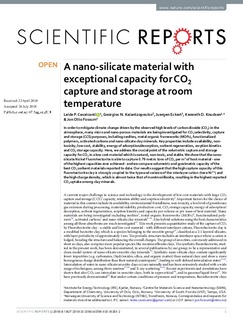A nano-silicate material with exceptional capacity for CO2 capture and storage at room temperature
| dc.contributor.author | Cavalcanti, Leide Passos | |
| dc.contributor.author | Kalantzopoulos, Georgios N. | |
| dc.contributor.author | Eckert, J. | |
| dc.contributor.author | Knudsen, Kenneth Dahl | |
| dc.contributor.author | Fossum, Jon Otto | |
| dc.date.accessioned | 2018-08-28T07:27:13Z | |
| dc.date.available | 2018-08-28T07:27:13Z | |
| dc.date.created | 2018-08-23T10:54:39Z | |
| dc.date.issued | 2018 | |
| dc.identifier.issn | 2045-2322 | |
| dc.identifier.uri | http://hdl.handle.net/11250/2559504 | |
| dc.description.abstract | In order to mitigate climate change driven by the observed high levels of carbon dioxide (CO2) in the atmosphere, many micro and nano-porous materials are being investigated for CO2 selectivity, capture and storage (CCS) purposes, including zeolites, metal organic frameworks (MOFs), functionalized polymers, activated carbons and nano-silicate clay minerals. Key properties include availability, non-toxicity, low cost, stability, energy of adsorption/desorption, sorbent regeneration, sorption kinetics and CO2 storage capacity. Here, we address the crucial point of the volumetric capture and storage capacity for CO2 in a low cost material which is natural, non-toxic, and stable. We show that the nano-silicate Nickel Fluorohectorite is able to capture 0.79 metric tons of CO2 per m3 of host material - one of the highest capacities ever achieved - and we compare volumetric and gravimetric capacity of the best CO2 sorbent materials reported to date. Our results suggest that the high capture capacity of this fluorohectorite clay is strongly coupled to the type and valence of the interlayer cation (here Ni2+) and the high charge density, which is almost twice that of montmorillonite, resulting in the highest reported CO2 uptake among clay minerals. | nb_NO |
| dc.language.iso | eng | nb_NO |
| dc.publisher | Nature Publishing Group | nb_NO |
| dc.rights | Navngivelse 4.0 Internasjonal | * |
| dc.rights.uri | http://creativecommons.org/licenses/by/4.0/deed.no | * |
| dc.title | A nano-silicate material with exceptional capacity for CO2 capture and storage at room temperature | nb_NO |
| dc.type | Journal article | nb_NO |
| dc.type | Peer reviewed | nb_NO |
| dc.description.version | publishedVersion | nb_NO |
| dc.source.volume | 8 | nb_NO |
| dc.source.journal | Scientific Reports | nb_NO |
| dc.source.issue | 1 | nb_NO |
| dc.identifier.doi | 10.1038/s41598-018-30283-2 | |
| dc.identifier.cristin | 1603954 | |
| dc.relation.project | Norges forskningsråd: 250728 | nb_NO |
| dc.description.localcode | © The Author(s) 2018. Open Access. This article is licensed under a Creative Commons Attribution 4.0 International License. | nb_NO |
| cristin.unitcode | 194,66,20,0 | |
| cristin.unitname | Institutt for fysikk | |
| cristin.ispublished | true | |
| cristin.fulltext | original | |
| cristin.qualitycode | 1 |
Tilhørende fil(er)
Denne innførselen finnes i følgende samling(er)
-
Institutt for fysikk [2653]
-
Publikasjoner fra CRIStin - NTNU [37236]

